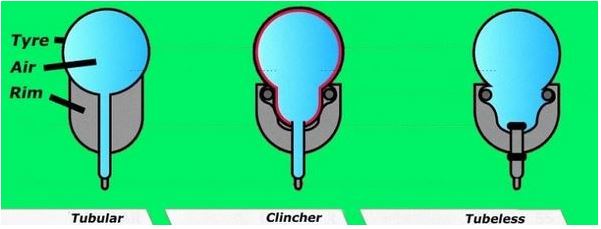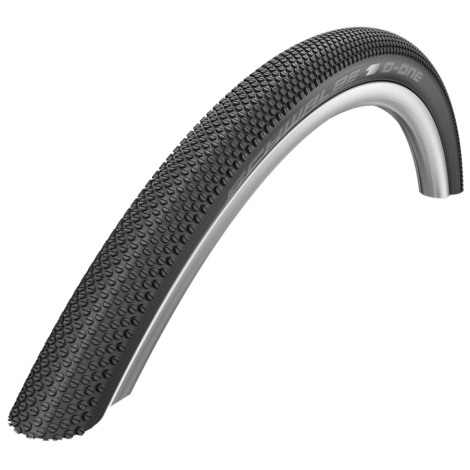There are a lot of different tyres available for gravel riding. These differ in how they fit the rim, their size (width & diameter) and tread pattern. So what do you need to consider when you buy a gravel tyre?

Fit
There are three alternative fit types with gravel tyres; Clincher, Tubeless and Tubular. The type of fit you need depends on your bike’s rims, they are either clincher or tubeless compatible. Tubular tyres are less common and high performance but are harder to live with as a day-today tyre.

Clincher tyres use a wire or kevlar bead around the edge of the tyre to hook onto the rim. Inner tubes hold the air and can be repaired or replaced in the event of a puncture. Clinchers developed to become a viable alternative to tubulars on road bikes in the early 1990’s, with tyres like Continental’s original Grand Prix (early version of the current GP5000). Most bikes come fitted with clincher tyres, they offer a good mix of practicality and performance for most bike riders.
Tubeless tyres have a special bead around the rim which hooks onto the (tubeless specific) rim more solidly than clinchers and offers an air tight seal. This technology banishes inner-tubes to the history parts bin, next to toe clips & straps. However, it requires tubeless compatible wheels, special valves, rim tapes and sealant to make a fully airtight wheel and tyre. Tubeless tyres can seal their own punctures, however they can be tricky and time consuming to initially set up.
Tubular tyres have traditionally offered the ultimate performance. Tyres are glued onto the rims, offering a lightweight, high performance option. Tubular tyres have been the choice of racers at the top of road racing for years. However, the inner tubes which hold the air are sewn into the tyre and are more difficult to repair. Replacing tubular tyres can take time and a fair amount of skill to glue the tyre so it is seated properly, all around the wheel.

Size
Gravel bikes with disc brakes and thru axles can use either 650b/ 27.5″ wheels or 700c. Smaller 650b/27.5″ wheels are lighter and more manoeuvrable, (they are a good option on smaller gravel bikes), 700c wheels roll along easier and tend to hold their momentum for longer, 700c is the size that most gravel bikes are supplied with as standard. The size of your bike’s existing tyre will be printed or moulded into the sidewall of the tyre.
Width
Wider tyres offer a bigger contact patch with the ground and offer a plush, comfier ride because of their bigger volume of air. However, they are heavier and can hold a lot of mud / dirt on the trails. Because they are heavier, they can feel a bit ‘tractor-ish’ and can be overkill on smoother gravel and roads. Narrower tyres offer less contact patch grip than a wider tyre at the same pressure, but can transmit vibrations and jolts over rougher terrain. However, narrower tyres weigh less and feel more road bike-like. So the ideal width for your bike’s tyres depends on the terrain you ride. I am currently riding 35mm Schwalbe G One’s on the mostly dry, fine grade gravel which I usually ride.

Gravel Tyre Tread
The most visible part of the tyre, where your bike makes contact with the ground, needs a bit of thinking about. The best place to start, is to think about the terrain which you are riding. Gravel bikes get used on all types of surfaces, from roads to fine compact gravel to filthy, muddy mountain bike trails.
Smooth Dry Gravel
Generally, more tightly packed / fine small knob (SK) tyre or more road like tread is better for faster, smoother, on and off-road surfaces – tyres such as the Schwalbe G One series (below) are great for this type of riding.
Mixed Terrain
Intermediate tyres offer a mix of fine tread / small knob centre bands with more spaced aggressive sides for cornering and climbing traction. These tyres offer a good middle-ground option between fast-rolling on smooth roads and gravel, as well as grip for climbing and cornering on varied terrain.
Loose / Muddy Terrain
Larger, more spaced out, ‘open-tread’ knobs are better for gripping rougher, loose gravel and mud. The Maxxis Ravager SS tyre (below) is a good example of a more open-tread tyre. More space between knobs allows mud to fall out and tyres remain grippy on softer ground.
Gravel Tyre Pressure
It’s not quite as simple as just getting the tyre for the terrain you ride. Tyre pressure can also have a huge effect on how your bike tyres perform, especially off-road. The ideal pressure for your tyres depends on lots of variables (including your weight, weather, terrain and type of tyre).
Tip: If you are unsure what pressures you should be riding, check the sidewall of your tyre for the recommended pressure range. If you are heavier than average, go for the upper end of the range, if you are lighter, go for the lower end of the range – you can always experiment riding higher or lower pressures on your usual trails.

Pinch Flat Punctures
Riding with softer tyre pressures increases the risk of pinch flat punctures with clincher tyress fitted with a tube. One of the big benefits of tubeless tyres is that they are better at running lower pressures and not puncturing. TPU inner tubes seem tougher to pierce and are more resistant to pinch flat punctures, although I haven’t dared to run them as soft as tubeless.
Gravel Tyre Care
Look after your tyres and they will look after you! Well, something like that. If you are riding tubeless tyres, keep them topped up with sealant and check your pressures now and again to see if they’ve lost any air. My rear tubeless Schwalbe tyre, below, lasted for 8500 kilometres of gravel riding and didn’t let me down once – my longest stretch of puncture free riding ever. (I don’t suggest you ride your tyres until the casing becomes visible).

Check out our full range (84) Gravel Bike and Cyclocross tyres here
Time to go Tubeless? Check out our tubeless gravel tyres and accessories here.



